Intel Confirms Some Details about 28-Core 5 GHz Demonstration
by Ian Cutress on June 8, 2018 12:45 AM EST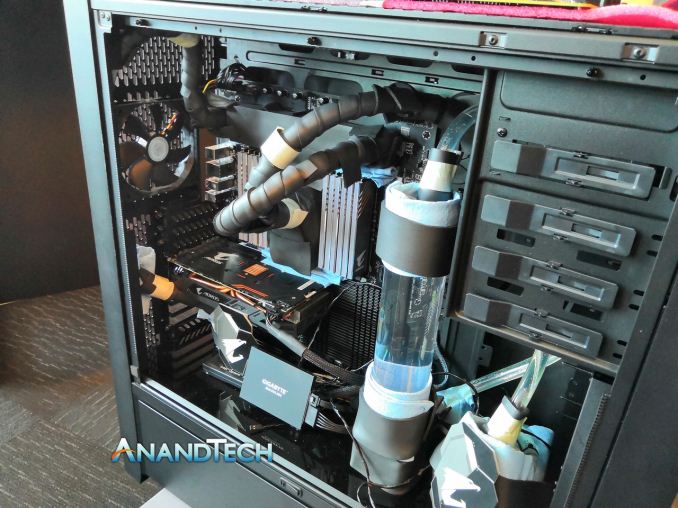
When Intel demonstrated its 28-core system running at 5 GHz at the Computex 2018 keynote this week, there were many questions surrounding the hardware and what was required in order to showcase this. The presentation was relatively light on details – perhaps purposefully so – however Intel SVP and GM Gregory Bryant stated that the processor was set to come out during Q4.
You can read our coverage about the launch in this article:
Intel's 28-Core 5 GHz CPU: Coming in Q4: Link
We also had a chance to examine the system that the demo was run on, in particular the cooling method and the motherboard. We have this article here:
We Got A Sneak Peek on Intel's 28-Core: All You Need to Know: Link
Now there were obviously a lot of questions about the demonstration. Was the CPU overclocked? What cooling was used? What platform did it run on? Which motherboard did it run on? What architecture is being used? What process node? What was the power consumption? We met with an Intel representative yesterday who answered some of these questions.
Was the CPU Overclocked?
The Intel representative did confirm the CPU was overclocked. We were told that on stage the presenter was actually meant to clarify that the system was overclocked, however the specific wording was not stated as it had been prepared.
There are many ways to interpret this – we did tell Intel that we had hoped that the presenter would have spent more time on stage talking about the system in play, discussing the platform it was running on, and making the system more ‘bright’ inside so that people could determine several things from photographs, rather than it looking almost like a black box with hidden pipes. Our commentary was taken on board by the Intel team we spoke to.
What cooling was used?
Intel confirmed that a water chiller was used, which we saw in our system demo examination the day after the presentation. We were told that it was not intended to showcase the cooling on the stage due to time constraints, to which we responded that Intel’s implementation of pre-overclocked systems in the past are typically accompainied a discussion on the pre-overclocked nature and the cooling used in the past, yet this presentation did not have this.
In our pre-briefing it was stated that this was a technical showcase (the bit where it was stated that this was coming to market was a bit of a shock if we’re honest), however this was not communicated as well as it should have been on stage. Again, Intel stated that they were taking our comments on board.
What Platform Did It Run On?
Intel did not answer this platform directly, however it was clear that the CPU was aimed at the LGA3647 server-based socket given from our examination of the demo system. It was unclear how Intel was going to promote this as an extreme workstation-type system, however Intel did note that they expect only a select market to be interested in this type of processor: a niche of a niche.
Intel know very well that there is a crowd of its customers that will buy performance at any price, and it doesn’t take a leap to suggest that this part is for those users.
Which Motherboard Did It Run On?
At the time of the presentation, Intel stated that they had partnered with both ASUS and GIGABYTE to create systems around the new 28-core product, however they didn’t state which system the 5 GHz demo was run on. We heard from both of the motherboard companies that it was actually the GIGABYTE system that hit 5 GHz, however it was noted that Intel did not explicitly call out the partner that hit the milestone. GIGABYTE confirmed that they certainly hit 5 GHz; we have yet to speak to ASUS on the matter. We do know that Intel quickly removed the CPUs in the demo systems from ASUS and GIGABYTE the next day with little notice. In between those times we have seen videos published from LinusTechTips (on ASUS) and Paul’s Hardware (on GIGABYTE) showing a Cinebench run.
What Architecture Did It Run? What Process Node?
The only item that Intel would confirm here is that the 28-core processor is built on one of its 14nm nodes. For anyone thinking it was a 10nm node, this confirms that it was not, however it does not say much more; Intel is purposefully keeping its cards close to its chest on this one. The smart money seems to be that the chip is likely to at least be based on the Skylake-X processors, like the 28-core Xeon Platinum 8176 or Xeon Platinum 8180, rather than the future Cascade Lake platform, however Intel has also promised that the consumer version of Cascade Lake-X will be coming by the end of the year.
Speaking with the motherboard vendors and OEMs in general about Intel’s HEDT plans is a tricky business, but most seem to be focused on their current X299 motherboards right now rather than a series of X299 refreshes that normally accompany an HEDT update.
What was the Power Consumption?
Again, this was one of the items that Intel wants to keep close to its chest. After confirming that the 5.0 GHz number was an overclocked value, it does mean that the base TDP for a ‘retail’ processor will be much lower, as the chip will be running at much lower clocks. The Xeon Platinum 8180 has a base frequency of 2.5 GHz and a turbo of 3.8 GHz for a TDP of 205W (TDP being defined at the base frequency only), and we know that the LGA3647 socket by its Intel reference design was made for chips up to 265W, so the frequency of the 28-core part shown by Intel for extreme workstations is only likely to be a +100-400 MHz more at most.
Interestingly enough, Intel states the maximum operating temperature of the 8180 at 205W TDP as 84C case temperature and 98C DTS, which sounds slightly higher than its standard settings for enterprise chips. It would mean that this new 28-core, if it comes out at 265W TDP, is likely to be a super high bin of the part. Of course, this will come with a higher cost.
One of the interesting numbers to come out of the initial announcement were that overclockers were seeing 1000W power draw for an 18-core Core i9-7980XE at 4.9 GHz, so one would assume that a 28-core at 5.0 GHz would be more. We know that the demo that achieved 5.0 GHz was using a Hailea water chiller capable of 1770W of cooling, and the system being used had a 1600W power supply with a low power graphics card. That gives us a good idea for low-bound and high-bound. However Intel would not help narrow down our estimates.
What Intel Needs To Do
One of our points to Intel was that the story around the 28-core announcement was not ideally communicated. (ed: this is an understatement) The systems holding the machines were not very well described in what they were doing, leading to massive amounts of speculation. The insides of the systems were dimly lit, and the cooling apparatus was hidden. Intel could have made the story around the parts be about the technology behind the demonstration, and the ability to push the limits of the hardware to new heights, however, even if the word ‘overclocked’ was accidentally not said on stage, these part of the story was not explained. Not in the ‘it wasn’t explained well’, it just wasn’t explained period. The best thing Intel can do at this point is to grab the story by the horns, and show that this is a passion project: let the readers and reviewers know about the platform, about the implementation (even if new explicit information isn’t shared), and that it actually takes a good amount of engineering prowess and skill to put on a 28-core, 5.0 GHz demonstration.
As it stands, we await further information.
| Want to keep up to date with all of our Computex 2018 Coverage? | ||||||
 Laptops |
 Hardware |
 Chips |
||||
| Follow AnandTech's breaking news here! | ||||||


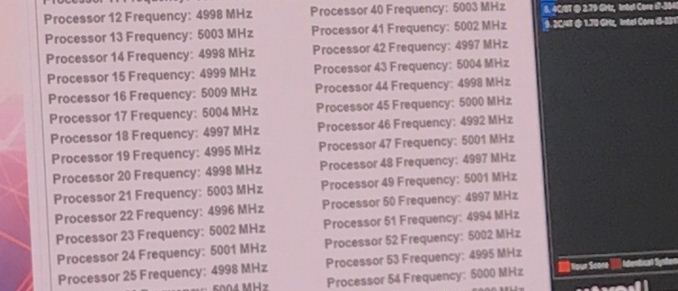
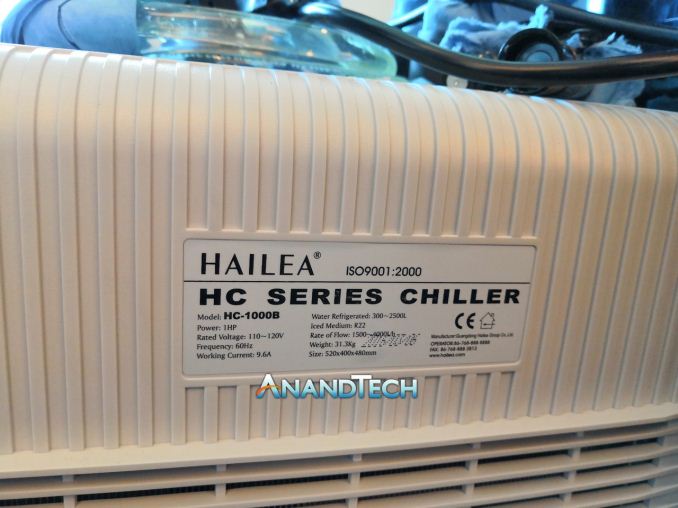
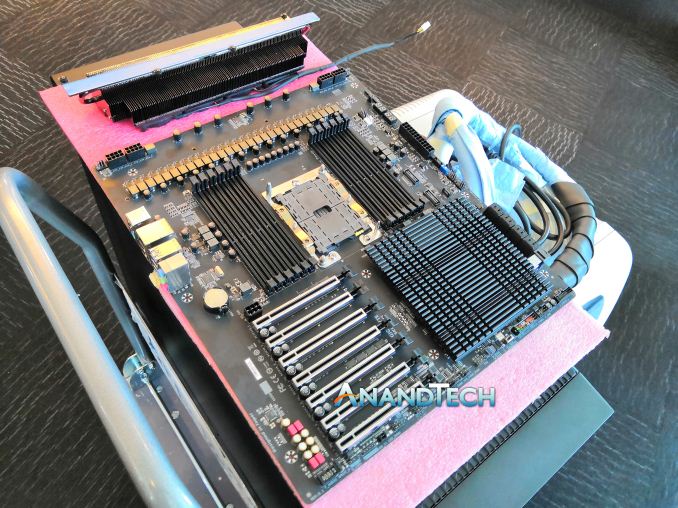
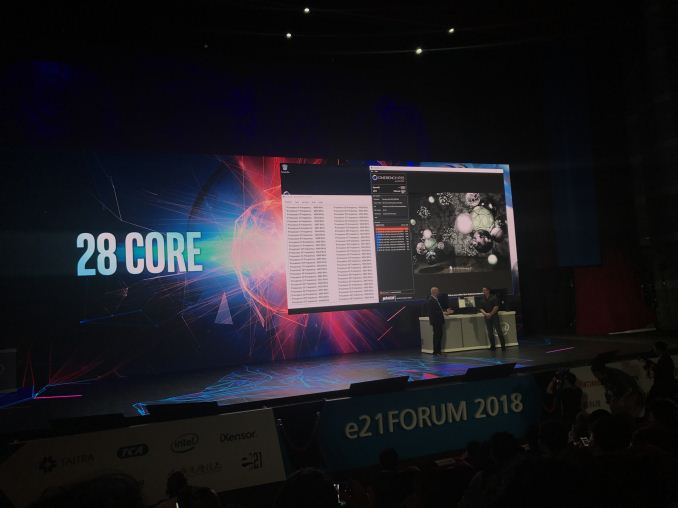








145 Comments
View All Comments
Spunjji - Friday, June 8, 2018 - link
No, but they sure as hell did their best to obscure just how not-stock this is (i.e. this is clearly not trivially achievable) and they asked the crowd if they want to be able to buy it. So yeah, deliberately misleading - a bait-and-switch at best.R0H1T - Friday, June 8, 2018 - link
No one with half a brain would OC a 28 core monstrosity to 5GHz. If you want 5GHz, or more, then go with CFL & if you want more cores ~ well there's TR part deux. Why is anyone defending this PR stunt by Intel, seriously all of the press was misled & yet they get the blame!Luckz - Friday, June 8, 2018 - link
The entire point of the demonstration was to mislead people who don't follow CPUs closely into thinking if AMD can do 24 or even 32 cores at something close to 4 GHz, Intel can do the same at 5. It's incredibly important to them to make people believe they have inherently superior hardware so that prospective buyers don't even do the value comparison with AMD. My girlfriend just told me yesterday that 'AMD are louder and need more power'. That's exactly the intended result.dwade123 - Friday, June 8, 2018 - link
Waah AMD’s CPU can’t overclock well. Therefore, shame on intel for overclocking theirs. This is a HEDT CPU. Intel showcased what their audience wanted and that is its overclocking ability. If anyone only wanted a dumped down workstation processor they’ll get a Threadripper.Targon - Friday, June 8, 2018 - link
The overclocking ability is maybe 4.7GHz at most, not 5GHz. If a typical closed loop liquid cooler or air cooling can't get a chip stable at a given speed, then it is not hitting that speed as an overclock. Even a "it only crashes once per hour" is not a valid stable overclock, even if you can run your benchmarks to completion.Basic concept, if Intel chips can be overclocked that easily, then why not just sell the chips at the higher clock speeds and leave it at that, instead of selling them in an underclocked form? It is because Intel wants the room to claim that each new generation chip is faster than the previous, even though they haven't really improved their chips all that much over the past six years!
FullmetalTitan - Friday, June 8, 2018 - link
AMD chips overclock just fine, everyone likes to pretend the motherboard vendors having to catch up to a new architecture with firmware updates somehow permanently crippled Zen parts.The issue here is that the intel demo used a rig that is only accessible to hedge fund managers. No remotely mainstream consumer, and probably 99% of their HEDT market, could afford the components to build the absurd cooling loop they used, the highly custom motherboard (29VRM???) and the power bill associated with operating this rig. It was incredibly dishonest to market it as a part that could OC like this, when it can only do so with many thousands of dollars of supporting equipment and dozens of hours of tuning.
Targon - Wednesday, June 13, 2018 - link
There is also something that many have missed, and that is that the motherboard itself had four 8-pin power connectors on it to provide the power to the socket needed. No motherboard that will ever be sold for the shipping Intel 28 core chip will provide that. Even if someone was willing to get a chiller to match the cooling of this Intel demo, no one will be able to buy a motherboard to allow it to happen.This would be like a single video card with six 8-pin power connectors on it for a demo. At no time would any company ship a video card with that many 8-pin power connectors on it, so a demo that shows a super-cooled video card running at very high speeds would also be something that no amount of cooling would make a consumer be able to hit those speeds.
The fact that articles were talking about the Intel 28-core 5GHz chip, which it is not, just shows how much of an intended deception the whole thing is.
sonichedgehog360@yahoo.com - Friday, June 8, 2018 - link
Then we have hundreds of thousands of brainless people on Reddit, Twitter, and Facebook...close - Friday, June 8, 2018 - link
@Ian and @Ryan. And if they thought otherwise they didn't bother to tell us, the unwashed masses.As it stands AT is either a mouthpiece for Intel or a collection of newbie journalists believing everything they're told.
voicequal - Friday, June 8, 2018 - link
The fact that Intel would borrow from their top Xeon design for an overclockable enthusiast part is significant news. There is still a lot we don't know, but that's not unusual for trade show announcements for forward leaning products.